筛选接近传感器和距离传感器技术的众多选择
投稿人:DigiKey 北美编辑
2024-09-18
使用接近传感器和距离传感器可在不进行物理接触的情况下检测物品的存在和位置,这在控制物料搬运、农业机械、制造和装配作业,以及食品、饮料和药品包装等工业流程方面非常重要。
这些传感器采用光电、激光、感应、电容、磁性和超声波等多种技术。在确定特定应用的最佳选择时,需要考虑范围、尺寸、精度、灵敏度、分辨率以及成本等因素。
许多应用的一个关键因素是待检测物体的材料。有些传感器在硬表面和纤维表面上的表现不同,还有一些传感器会受到物体颜色或反射率的影响。
本文将回顾常见的非接触式接近传感器技术,并介绍这些技术的工作原理、基本性能特点和 SICK 的示例传感器,以及一些预期应用。
光电传感器
光电传感器(如 SICK 的 W10 光电接近传感器)不仅易于使用和安装,而且具有适合多种应用的一系列特性。W10 传感器采用坚固的设计,因此适合在具有挑战性的环境中精确检测物体。集成式触摸屏可加快参数设置和传感器部署速度(图 1)。
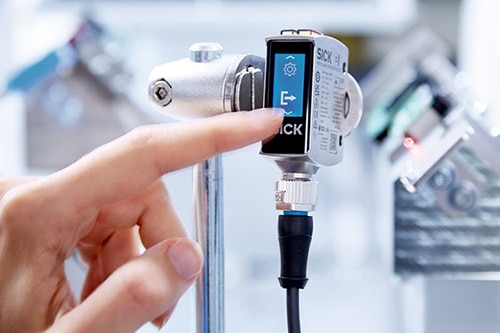 图 1:这些光电传感器上的触摸屏可加快调试和部署速度。(图片来源:SICK)
图 1:这些光电传感器上的触摸屏可加快调试和部署速度。(图片来源:SICK)
借助提供的教程,设计人员能够根据特定应用要求调整这些传感器。此外,集成速度设置、标准和精密测量模式以及前景和背景抑制等功能,意味着一个传感器可用于多种应用。该传感器系列包括四种型号,它们的工作距离和安装方式各不相同。
背景抑制
具有背景抑制 (BGS) 功能的光电接近传感器在发送元件与接收元件之间采用三角测量法。所设定感应范围后方的物体的信号会被抑制。此外,SICK 的 BGS 技术还能忽略背景中的高反射物体,并能应对复杂的环境照明条件。
如果目标物体和背景(如传送带)具有相似的反射率,或者背景反射率变化不定,可能对检测造成干扰,则背景抑制尤其有用。
前景抑制
具有前景抑制 (FGS) 功能的光电接近传感器可检测规定距离内的物体。传感器与感应距离(设置为背景)之间的所有物体都会被检测到。为确保可靠的感测,背景需要相对明亮,而且高度不应变化。
当物体位于白色或浅色传送带等反光表面上时,前景抑制可改善检测效果。传感器不是通过检测物体反射的光线,而是通过检测传送带反射的光线是否消失,来检测物体。
回射式
在回射式传感器中,发出的光线照射到反射器上,而传感器对反射的光线进行评估。使用偏振滤光片可将误差降至最低。透明的拉伸膜和塑料包装会干扰这些传感器。降低传感器灵敏度有助于克服这些挑战。此外,用激光器取代标准红外光发射器可获得更大的感应范围和更高的分辨率。
采用低于正常值的开关滞后可提高回射式传感器的性能。在这些设计中,即使是传感器与反射器之间最微弱的光衰减,例如由玻璃瓶引起的光衰减,也能被可靠地检测到。SICK 还提供一个称为 AutoAdapt 的监控系统,该系统可持续调节和调整开关阈值,以应对可能导致感应系统失灵的污染物逐渐积聚现象。
对射式
与回射式传感器不同,对射式传感器采用两个有源器件:发送器和接收器。对射式感应可实现更远的感应范围。用激光二极管取代红外发射器可进一步扩大感应距离,同时还能保持高分辨率和精确感应。
光纤
光纤传感器是对射式设计的一种变体。在光纤光电传感器中,发送器和接收器共同封装在一个外壳内。发送器和接收器分别使用不同的光纤电缆。这些传感器尤其适用于高温应用以及危险和恶劣的环境。
光电传感器阵列
RAY26 Reflex Array 系列光电传感器(如型号 1221950)不仅能可靠地检测扁平物体,而且还能实现快速调试。与反射器结合使用时,这种光电传感器还能检测小至 3 mm 的小型、扁平、透明或不平整物体。在 55 mm 高的均匀光阵列中,传感器可检测物体的前缘。这意味着,即使是穿孔物体,也能可靠地检测到,而且无需进行复杂的切换操作(图 4)。
 图 2:光电传感器阵列可在 55 mm 高的区域内检测小至 3 mm 的物体。(图片来源:SICK)
图 2:光电传感器阵列可在 55 mm 高的区域内检测小至 3 mm 的物体。(图片来源:SICK)
激光距离传感器
以下应用的设计人员可选择使用 DT50 激光距离传感器:储存容器中的液位监测、传送带上物体的位置检测、自动叉车系统中轴的 XY 位置、仓库和悬挂输送机中起重机的垂直定位,以及线圈绕制过程中的直径监测。这些传感器采用反射激光,不受环境光线影响,而且工作精确可靠,支持长达数米的飞行时间 (ToF) 距离测量。
例如,DT50-2B215252 的测量范围为 200 mm 至 30,000 mm,并且具有多项特性,其中包括:
- 外壳坚固,防护等级为 IP65 和 IP67
- 每秒可提供多达 3,000 次距离测量
- 极短的响应时间:0.83 ms
- 外壳紧凑,支持从工业机器人到测量储存容器填充高度等一系列应用
利用统计数据进行高分辨率测量
高清距离测量+ (HDDM+) 是一种高分辨率 ToF 测量技术,可用于激光距离传感器、光检测传感器和测距 (LiDAR) 传感器。与单脉冲或相位相关感应技术相比,HDDM+ 是一种统计测量方法。
传感器软件会对多个激光脉冲的回波进行统计评估,以过滤掉来自玻璃、雾、雨、灰尘、雪、树叶、栅栏和其他物体的干扰,从而计算出与预定目标的距离。即使在具有挑战性的环境条件下,产生的距离测量结果也具有很高的确定性(图 5)。
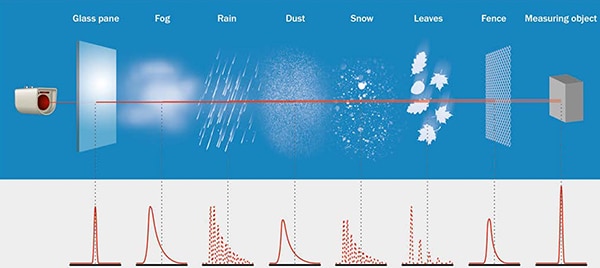 图 3:SICK 的 HDDM+ 软件使用统计评估过程来消除来自玻璃板、雾、雨、灰尘、雪、树叶和栅栏等的“噪声”。(图片来源:SICK)
图 3:SICK 的 HDDM+ 软件使用统计评估过程来消除来自玻璃板、雾、雨、灰尘、雪、树叶和栅栏等的“噪声”。(图片来源:SICK)
HDDM+ 技术的典型应用包括电子产品生产中用于质量控制的距离测量、机械和设备工程中的 LiDAR 多维物体检测和位置确定,以及工业起重机或车辆的位置确定。
HDDM+ 传感器在回射带上的感应范围可达 1.5 km。例如,型号 DT1000-S11101 的测量范围可达 460 m,对自然物体的典型测量精度为 ±15 mm,分辨率可调范围为 0.001 mm 至 100 mm。
电感式
电感式接近传感器(如 SICK 的 IME 系列)可检测含铁和非铁金属物体。这些传感器由电感器-电容器 (LC) 谐振电路组成,该电路可产生高频交变电磁场。当金属物体进入检测范围时,该磁场会受到抑制。这种抑制会被信号评估电路检测到,然后放大器会产生输出信号(图 4)。
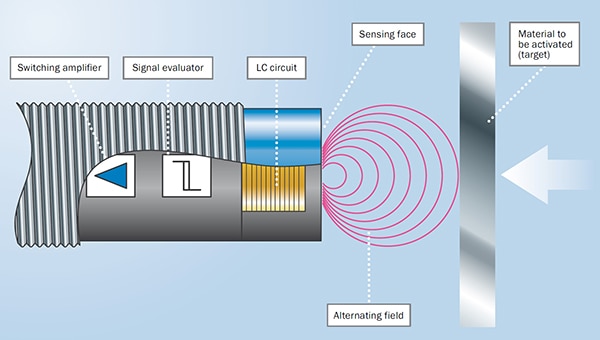 图 4:基础电感式接近传感器由产生交变磁场的 LC 电路、信号评估器以及放大器组成。(图片来源:SICK)
图 4:基础电感式接近传感器由产生交变磁场的 LC 电路、信号评估器以及放大器组成。(图片来源:SICK)
多种接近传感器技术的感应距离有两个重要技术参数,即标称感应距离 (Sn) 和可靠感应距离 (Sa)。Sn 不考虑制造公差或工作温度等外部影响。Sa 既考虑制造公差,又考虑工作条件的变化。Sa 通常约为 Sn 值的 81%。例如,型号为 IME08-02BPSZT0S 的电感式传感器的 Sn 为 2 mm,Sa 为 1.62 mm。
电容式感应
与电感式传感器类似,电容式接近传感器也使用振荡器。在这种情况下,使用的是开放式电容器,传感器中的有源电极会产生相对于地的静电场。这些传感器可检测包括金属和非金属物体在内的多种材料的存在。
当物体进入静电场时,谐振电路中的振荡幅度会根据材料的介电特性发生变化。信号评估器会检测到这种变化,然后放大器会产生输出信号(图 5)。
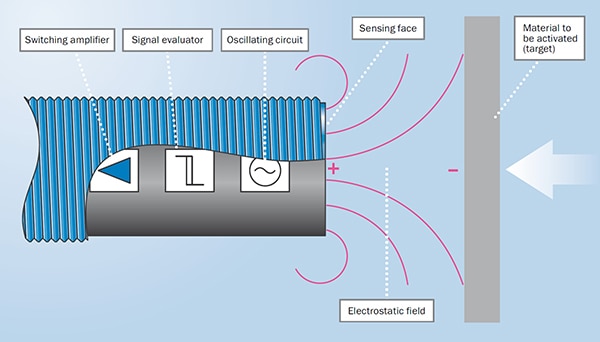 图 5:在电容式接近传感器中,振荡电路会产生静电场,当待感应的目标进入静电场时,静电场的特性会发生变化。(图片来源:SICK)
图 5:在电容式接近传感器中,振荡电路会产生静电场,当待感应的目标进入静电场时,静电场的特性会发生变化。(图片来源:SICK)
与电感式接近传感器类似,电容式接近传感器也有几个与感应距离相关的技术参数,其中包括 Sn、Sa 和折减系数。例如,型号 CM12-08EBP-KC1 的 Sn 为 8 mm,标称 Sa 为 5.76 mm。
待感测的物体必须至少与传感器表面一样大,而且感应距离随材料的折减系数而变化。折减系数与材料的介电常数有关,例如,金属和水为 1,聚氯乙烯 (PVC) 为 0.4,玻璃为 0.6,陶瓷为 0.5。
磁性
磁性接近传感器会对磁体的存在做出响应。SICK 的磁性接近传感器采用了两种检测技术:
- 巨磁阻 (GMR),这种传感器基于电阻器,其电阻值会在存在磁场时发生变化。惠斯通电桥用于检测电阻变化并产生输出信号。MZT7 气缸传感器(如设计用于 T 型槽气缸的 MZT7-03VPS-KP0)采用 GMR 技术检测气动驱动装置和类似应用中的活塞定位。
- LC 技术采用谐振幅度很小的谐振电路。如果外部磁场接近,谐振幅度会增大。这种增大会被信号评估器检测到,然后放大器会产生输出信号(图 6)。MM08-60APO-ZUA 的 Sn 为 60 mm,Sa 为 48.6 mm。
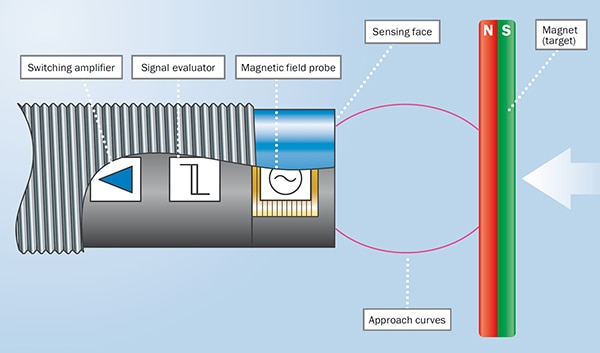 图 6:在磁性接近传感器中,磁场探头可采用 GMR 或 LC 技术。(图片来源:SICK)
图 6:在磁性接近传感器中,磁场探头可采用 GMR 或 LC 技术。(图片来源:SICK)
超声波传感器
对于 8 m 以内的物体,设计人员可选择使用超声波传感器,如 SICK 的 UM30 系列。这些传感器集成了温度补偿功能,可提高测量精度,并提供不受颜色影响的物体检测功能、防尘性以及高达 +70°C 的工作温度。它们根据飞行时间技术测量距离,距离等于声速乘以总声波飞行时间 (t2),再除以 2(图 6)。
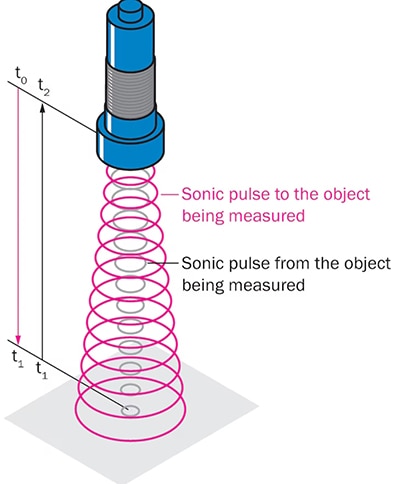 图 7:超声波传感器可根据声波的总飞行时间 (t2) 来测量距离。(图片来源:SICK)
图 7:超声波传感器可根据声波的总飞行时间 (t2) 来测量距离。(图片来源:SICK)
型号为 UM30-212111 的超声波传感器适用于空箱监测等应用。内部温度监测器的测量精度为 ±1%。即使在有污垢和灰尘的情况下,这些不受颜色影响的传感器也能检测到难以分辨的物体。
结语
好消息是,有多种接近传感器和距离传感器技术可供选择。这意味着各种应用需求都有相应的解决方案。我们面临的挑战是在众多选择中进行筛选,找到在实际应用和工作条件下检测特定材料的最佳解决方案。

免责声明:各个作者和/或论坛参与者在本网站发表的观点、看法和意见不代表 DigiKey 的观点、看法和意见,也不代表 DigiKey 官方政策。







 中国
中国